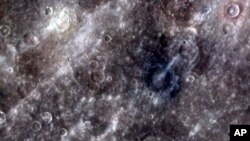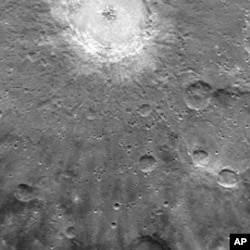Scientists controlling the U.S. space agency’s MESSENGER space probe have released the first photographs of Mercury taken by the robotic craft since it began orbiting the solar system's innermost planet March 17. The detailed images show a rocky surface pocked with craters, and provide what mission scientists called the "barest hint" of revelations to come.
Click here to see slideshow of MESSENGER's photos of Mercury
The more than two dozen images taken by MESSENGER’s wide angle camera during its 24 orbits around Mercury reveal numerous crater impacts and what scientists call secondary impacts, smaller craters made by flying debris or ejecta from the initial impacts.
The most prominent of the craters is named Debussy, in honor of the French classical music composer, Claude Debussy.
Bright rays, consisting of impact ejecta and secondary craters, radiate from Debussy and extend for hundreds of kilometers across Mercury's surface.
Sean Solomon of the Carnegie Institution of Washington is principal investigator for the MESSENGER mission and a member of the MESSENGER team at Johns Hopkins University Applied Physics Laboratory in Maryland.
Solomon says Mercury’s surface is quite dark due to a phenomenon known as space weathering. Using the moon as a reference, Solomon says the brighter areas near the impact craters are younger, possibly dating to within the past billion years.
Mercury’s surface had been viewed previously in the mid-1970’s with fly-bys by the U.S. space probe Mariner 10 and by MESSENGER itself, prior to entering the planet’s orbit on March 17.
New view
But Solomon says astronomers are now viewing the tiny planet in an entirely new way.
"We’re really seeing Mercury now with new eyes, and as a result, our entire global perspective is unfolding and as a result, this extremely dynamic planet, which changes it’s magnetosphere and it’s atmosphere on a time scale of minutes and hours, will be on continuous display for the first time," Solomon explained.
The magnetosphere is a region around Mercury dominated by a magnetic field. It is formed when charged particles from the Sun’s solar winds are repelled by Mercury’s natural magnetic field, which is substantial. Other planets, including Earth, have weaker magnetospheres.
Many mysteries
Mercury’s magnetic field, its massive iron core at least twice the density of Earth's, and possible ice deposits within dark craters near the poles, are just some of the mysteries scientists are hoping to solve during the year long MESSENGER mission.
Solomon says scientists expect to collect 75,000 images of the scorching planet during the mapping phase of a planet that has been the wonder of ancient philosophers.
"And we’re now there," Solomon said. "That point of light in the sky is the object of our study by an observatory that is now orbiting the planet and is about to embark on a year of orbital observations on an essentially continuing basis, and it’s just a wonderful thrill."
Next week, MESSENGER’S seven on-board instruments and scientific radio equipment will start formally taking measurements and mapping the surface of the solar system’s smallest planet more than 106 million kilometers from Earth.






